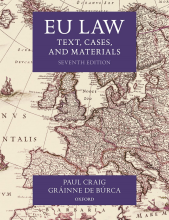Summary: Institutional And Substantive Law Of The Eu
- This + 400k other summaries
- A unique study and practice tool
- Never study anything twice again
- Get the grades you hope for
- 100% sure, 100% understanding
Read the summary and the most important questions on Institutional and Substantive Law of the EU
-
Introduction Internal Market (Week 1)
This is a preview. There are 23 more flashcards available for chapter 02/11/2020
Show more cards here -
Why the internal market? What is the rationale of the internal market?
- IDEOLOGY -> No more war (establishment of ECSC )
- SELF INTEREST (ECONOMIC) -> BUT: give in some of sovereignty
- Free trade protects Member State from another Member State's protectionism (which will economically benefit them)
- Wealth of Nations (Adam Smith)
- font-sizeLeutwiler Report -> WTO
-
Comparative advantage (+) on common market
Riccardo (1817 ) -> Cloth and wine example- (
Spaak Report1956 ->ECSC ) --> On the functioning of the common market - When a country produces 'everything', it is not necessarily more efficient
- With CA: Countries focus on their specialty and are more efficient producing one product in which they thrive instead of two in which they do not. --> increase in size of production
-
Comparative advantage (-) on common market
Why do ideal situations almost never occur?- Trade barriers
Information failureTransaction costsBuyers and seller act rationallyDifficult market access due to diverging local regulations
-
From a Common Market to a Single Market(The internal market towards 'a perfect world')
Market integration
Banning protectionism
- Ban on quantitive restrictions +
MEQRS (measures)
- Ban on discriminatory national taxes
- Harmonization of labour law, pensions, diploma requirements
- Ban on anti-competitive behavior
- Of
States - Of companies
-
Stages of economic integration (<)
- Free Trade
Customs Union- Common Market
- Economic Union (Single Market)
- Political Union
- Free Trade
-
Completing the Internal Market: Single European Act (2)
- 1986
- New legal basis (Art. 114, (115) + 26, 27 TFEU)
- Introduction QMV (prior: Unanimous)
- From common market --> single market --> internal market
- Deadline:
31st December1992 --> But ever evolvingprocess
-
Integration process of the Internal Market
- Monnet Method (
Neofuntionalism ) - Spill-over effects (political, economic, cultural)
- Monnet Method (
-
Positive vs. Negative integration regarding the shift--> from a Common Market to a Single Market
Positive (market integration): This refers to the creation of a common sovereignty through the modification of existing institutions and the creation of new ones.- Harmonization
- Modification of existing policies
- Joint execution of powers
Negative (market integration): This implies the elimination of barriers that restrict the movement of goods, services and factors of production.- Eliminating obstacles
- Removal of discriminatory behavior
- CJEU, Gaston Schul, case 15/81
The internal market is NOT either/or --> it is always a mix and balance (yin/yang) -
Full Harmonization with direct effect law obligation
- Consumer or company, MS cannot blame national
government forissuing certain legislation based on the four freedoms - Because it is the
EU top-down (total power) telling the membersates to act in a certain way - Direct effect of an
EU law obligation
- Consumer or company, MS cannot blame national
-
Alternatives for mutual recognition (Host country control)
- Host country control: Free movement of services
—> Host countrydetermines whether foreign service has access to the markettempered with a rule ofnon-discrimination (therefore limited) + country cannot just ban any service or product for protectionist motives - Host country control: Free movement of services
- Higher grades + faster learning
- Never study anything twice
- 100% sure, 100% understanding
































